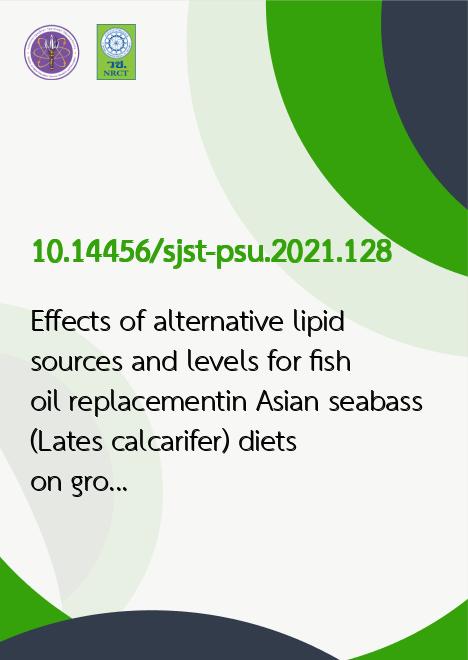
|
Effects of alternative lipid sources and levels for fish oil replacementin Asian seabass (Lates calcarifer) diets on growth,digestive enzyme activity and immune parameters |
|---|---|
| รหัสดีโอไอ | |
| Creator | 1. Md. Arefin Rahman 2. Chutima Tantikitti 3. Naraid Suanyuk 4. Teerapun Talee 5. Bullika Hlongahlee 6. Sudarat Chantakam 7. Manee Srichanun |
| Title | Effects of alternative lipid sources and levels for fish oil replacementin Asian seabass (Lates calcarifer) diets on growth,digestive enzyme activity and immune parameters |
| Publisher | Research and Development Office, Prince of Songkla University |
| Publication Year | 2564 |
| Journal Title | Songklanakarin Journal of Science and Technology (SJST) |
| Journal Vol. | 43 |
| Journal No. | 4 |
| Page no. | 976-986 |
| Keyword | alternative lipid sources, fish oil, Lates calcarifer, growth, immune responses |
| URL Website | https://rdo.psu.ac.th/sjstweb/index.php |
| ISSN | 0125-3395 |
| Abstract | An experiment was conducted using factorial (3?4) in completely randomized design to examine incorporation ofvegetable oils in diets on seabass growth, fatty acid profile, digestive enzyme activity and immune responses. Ten isonitrogenous and iso-lipidic diets were formulated to have soybean, palm and sunflower oil replacing fish oil (FO) at 0%, 25%,50% and 75%, respectively. Each diet was fed to quadruplicate fish groups (3.29?0.30g initial weight) for eight weeks. Resultsrevealed interaction effects between oil types and replacement levels on diet consumption among the feeding groups. Fish growthand immune parameters were not affected by oil types (p?0.05), but final weight, specific growth rate, white blood cell andserum protein were altered by replacement levels (p<0.05). Carcass protein and lipid were influenced by oil types andreplacement levels. The highest and lowest carcass protein content was observed in fish fed diets having 75% and 25% soybeanoil, respectively while the rest of the feeding groups were similar to the control group. Fatty acid profile of fish carcass reflectedoil sources. The ratio of ?-linolenic acid (18:3n-3) and linoleic acid (18:2n-6) was similar to those fed 100% FO containing dietand 25% palm oil replaced diet. Specific trypsin and lipase activity were affected by oil types and replacement levels in intestineand pyloric caeca, respectively. Diets replaced with soybean and palm oil showed similar results in intestinal specific trypsinactivity. The highest specific lipase activity was detected in fish fed 100% FO containing diets followed by 25%, 50% and 75%FO replaced diets, respectively. Therefore, soybean or palm oils can replace FO at 25% in Asian seabass diet withoutcompromising growth and health status. |
